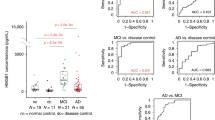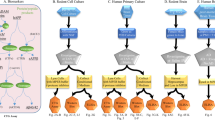Abstract
The present study was designed to further explore the potential cause/effect relationship between the expression of both the N141I presenilin (PS)2 mutant familial Alzheimer's disease (FAD) gene and cyclooxgenase (COX) in respect to the mechanism associated with programmed cell death in Alzheimer's disease (AD). We found that expression of mutant N141I PS2 resulting in apoptotic cell death in H4 neuronal cells coincided with >4-fold induction in the expression of the inducible form of COX-2, but not the constitutive COX-1. Moreover, we found that the expression of the N141I PS2 FAD gene strongly promoted (>2-fold) glycogen synthase kinase (GSK)-3β activity coincidental with a reduction in the level of β-catenin translocated from the cytoplasmic to the nuclear compartment. Most interestingly, we found that inhibition of COX-2-mediated generation of prostaglandin (PG)-E2 in H4 neuronal cells with the preferential COX-2 inhibitor nimesulide protects against N141I PS2-mediated apoptotic cell death coincidental with an inhibition of GSK-3β activity and subsequent normalization of β-catenin cellular distribution. The clinical relevance of this finding was confirmed by the evidence that COX-2 protein and PG-E2 concentrations were selectively increased >2-fold in the cerebral cortex of subjects harboring the N141I PS2 FAD mutation relative to wild-type PS2 AD cases. This study demonstrates for the first time that COX-2 may be a downstream effector of mutant N141I PS2-mediated apoptotic cell death and that inhibition of COX-2 may neuroprotect in AD through modulation of a GSK-3β–β-catenin-mediated response. The study provides support for the potential pharmacogenomic identification of N141I PS2 FAD cases that might preferentially benefit from inhibition of COX-2 during the progression of clinical dementia.
This is a preview of subscription content, access via your institution
Access options
Subscribe to this journal
Receive 12 print issues and online access
$259.00 per year
only $21.58 per issue
Buy this article
- Purchase on Springer Link
- Instant access to full article PDF
Prices may be subject to local taxes which are calculated during checkout







Similar content being viewed by others
Abbreviations
- AD:
-
Alzheimer's disease
- Aβ:
-
beta-amyloid peptide
- βAPP:
-
β-amyloid precursor protein
- COX:
-
cyclooxygenase
- FACS:
-
fluorescence-activated cell sorter
- FAD:
-
familial AD
- FITC:
-
fluorescein isothiocyanate
- HRP:
-
horseradish peroxidase
- GSK-3β:
-
glycogen synthase kinase-3β
- MTT:
-
3-(4,5-dimethylthiazol-2-yl)-2,5-diphenyltetrazolium bromide
- PBS:
-
phosphate buffered saline
- PS:
-
presenilin
- PI:
-
propidium iodide
- PG:
-
prostaglandin
- Tcf/Lef1:
-
T-cell factor/lymphoid-enhancing factor-1
- TBS:
-
Tris-buffered saline
- WT:
-
wild type
References
Zandi PP, Anthony JC, Hayden KM, Mehta K, Mayer L, Breitner JC . Reduced incidence of AD with NSAID but not H2 receptor antagonists (2002). Neurology 2002; 59: 880–886.
Veld BA, Ruitenberg A, Hofman A, Launer LJ, Van Duijn CM, Stijnen T et al. Nonsteroidal antiinflammatory drugs and the risk of alzheimer's disease. N Engl J Med 2001; 345: 1515–1521.
Launer L . Nonsteroidal anti-inflammatory drug use and the risk for Alzheimer's disease: dissecting the epidemiological evidence. Drugs 2003; 63: 731–739.
McGeer PL, Schulzer M, McGeer EG . Arthritis and anti-inflammatory agents as possible protective factors for Alzheimer's disease: a review of 17 epidemiologic studies. Neurology 1996; 47: 425–432.
Zandi PP, Breitner JC . Do NSAIDs prevent Alzheimer's disease? And, if so, why? The epidemiological evidence. Neurobiol Aging 2001; 22: 811–817.
Martin BK, Meinert CL, Breitner JC, ADAPT Research Group. Double placebo design in a prevention trial for Alzheimer's disease. Control Clin Trials 2002; 23: 93–99.
Rogers J, Kirby LC, Hempelman SR, Berry DL, McGeer PL, Kaszniak AW et al. Clinical trial of indomethacin in Alzheimer's disease. Neurology 1993; 43: 1609–1611.
Scharf S, Mander A, Ugoni A, Vajda F, Christophidis N . A double-blind, placebo-controlled trial of diclofenac/misoprostol in Alzheimer's disease. Neurology 1999; 53: 197–201.
Aisen PS, Schafer KA, Grundman M, Pfeiffer E, Sano M, Davis KL et al. Effects of rofecoxib or naproxen vs placebo on Alzheimer disease progression. J Am Med Assoc 2003; 289: 2819–2826.
Aisen PS, Davis KL, Berg JD, Schafer K, Campbell K, Thomas RG et al. A randomized controlled trial of prednisone in Alzheimer's disease. Neurology 2000; 54: 588–593.
Pasinetti GM, Pompl PN . Cyclo-oxygenase inhibitors and Alzheimer's: are we well ADAPTed? Lancet Neurol 2002; 7: 403–404.
Pasinetti GM . Cyclooxygenase and inflammation in Alzheimer's disease: experimental approaches and clinical interventions. Neurosci Res 1998; 54: 1–6.
Kim TW, Pettingell WH, Hallmark OG, Moir RD, Wasco W, Tanzi RE . Endoproteolytic cleavage and proteasomal degradation of presenilin 2 in transfected cells. J Biol Chem 1997; 272: 11006–11010.
Mirjany M, Ho L, Pasinetti GM . Role of cyclooxygenase-2 in neuronal cell cycle activity and glutamate-mediated excitotoxicity. J Pharmacol Exp Ther 2002; 301: 494–500.
Ho L, Qin W, Pompl PN, Xiang Z, Wang J et al. Diet-induced insulin resistance promotes amyloidosis in a transgenic mouse model of Alzheimer's disease. FASEB J 2004; 18: 902–904.
Qin W, Ho L, Pompl PN, Peng Y, Zhao Z, Xiang Z et al. Cyclooxygenase (COX)-2 and COX-1 potentiate beta-amyloid peptide generation through mechanisms that involve gamma-secretase activity. J Biol Chem 2003; 278: 50970–50977.
Pompl PN, Ho L, Bianchi M, McManus T, Qin W, Pasinetti GM . A therapeutic role for cyclooxygenase-2 inhibitors in a transgenic mouse model of amyotrophic lateral sclerosis. FASEB J 2003; 6: 725–727.
Weihl CC, Ghadge GD, Kennedy SG, Hay N, Miller RJ, Roos RP . Mutant presenilin-1induces apoptosis and downregulates Akt/PKB. J Neurosci 1999; 19: 5360–5369.
Huelsken J, Behrens J . The Wnt signalling pathway. J Cell Sci 2002; 115: 3977–3978.
Hwang DY, Chae KR, Kang TS, Hwang JH, Lim CH, Kang HK et al. Alterations in behavior, amyloid beta-42, caspase-3, and Cox-2 in mutant PS2 transgenic mouse model of Alzheimer's disease. FASEB J 2002; 16: 805–813.
Bhat RV, Shanley J, Correll MP, Fieles WE, Keith RA, Scott CW et al. Regulation and localization of tyrosine216 phosphorylation of glycogen synthase kinase-3 beta in cellular and animal models of neuronal degeneration. Proc Natl Acad Sci USA 2000; 97: 11074–11079.
Ikeda S, Kishida S, Yamamoto H, Murai H, Koyama S, Kikuchi A . Axin, a negative regulator of the Wnt signaling pathway, forms a complex with GSK-3beta and beta-catenin and promotes GSK-3beta-dependent phosphorylation of beta-catenin. EMBO J 1998; 17: 1371–1384.
Hoshi M, Takashima A, Noguchi K, Murayama M, Sato M, Kondo S et al. Regulation of mitochondrial pyruvate dehydrogenase activity by tau protein kinase I/glycogen synthase kinase 3beta in brain. Proc Natl Acad Sci USA 1996; 93: 2719–2723.
Graef IA, Mermelstein PG, Stankunas K, Neilson JR, Deisseroth K, Tsien RW et al. L-type calcium channels and GSK-3 regulate the activity of NF-ATc4 in hippocampal neurons. Nature 1999; 401: 703–708.
Woodgett JR . Molecular cloning and expression of glycogen synthase kinase-3/factor A. EMBO J 1990; 9: 2431–2438.
Chong ZZ, Li F, Maiese K . Activating Akt and the brain's resources to drive cellular survival and prevent inflammatory injury. Histol Histopathol 2005; 20: 299–315.
Willert K, Nusse R . Beta-catenin: a key mediator of Wnt signaling. Curr Opin Genet Dev 1998; 8: 95–102.
Zhang Z, Hartmann H, Do VM, Abramowski D, Sturchler-Pierrat C, Staufenbiel M et al. Destabilization of β-catenin by mutations in presenilin-1 potentiates neuronal apoptosis. Nature 1998; 395: 698–702.
De Ferrari GV, Chacon MA, Barria MI, Garrido JL, Godoy JA, Olivares G et al. Activation of Wnt signaling rescues neurodegeneration and behavioral impairments induced by beta-amyloid fibrils. Mol Psychiatry 2003; 8: 195–208.
Garrido JL, Godoy JA, Alvarez A, Bronfman M, Inestrosa NC . Protein kinase C inhibits amyloid beta peptide neurotoxicity by acting on members of the Wnt pathway. FASEB J 2002; 16: 1982–1984.
Lukiw WJ, Bazan NG . Strong nuclear factor-kappaB-DNA binding parallels cyclooxygenase-2 gene transcription in aging and in sporadic Alzheimer's disease superior temporal lobe neocortex. J Neurosci Res 1998; 53: 583–592.
Bazan NG . COX-2 as a multifunctional neuronal modulator. Nat Med 2001; 7: 414–415.
Bazan NG, Colangelo V, Lukiw WJ . Prostaglandins and other lipid mediators in Alzheimer's disease. Prostaglandins Other Lipid Mediat 2002; 68–69: 197–210.
Hida T, Kozaki K, Muramatsu H, Masuda A, Shimizu S, Mitsudomi T et al. Cyclooxygenase-2 inhibitor induces apoptosis and enhances cytotoxicity of various anticancer agents in non-small cell lung cancer cell lines. Clin Cancer Res 2000; 6: 2006–2011.
Mirza NM, Huey ED, Dustin IH, Myers M, Overman J, Phillips B et al. Short-term effect of statins and NSAIDs on CSF beta-amyloid1-42 in healthy controls. Alzheimer's Association International Conference on Prevention of Dementia; June 18–21, Washington DC, 2005, Abstract #O2-02-08.
Dihlmann S, Kloor M, Fallsehr C, von Knebel Doeberitz M . Regulation of AKT1 expression by beta-catenin/Tcf/Lef signaling in colorectal cancer cells. Carcinogenesis 2005; 26: 1503–1512.
Xiang Z, Ho L, Valdellon J, Borchelt D, Kelley K, Spielman L et al. Cyclooxygenase (COX)-2 and cell cycle activity in a transgenic mouse model of Alzheimer's disease neuropathology. Neurobiol Aging 2002; 23: 327–334.
Pompl PN, Yemul S, Xiang Z, Ho L, Haroutunian V, Purohit D et al. Caspase gene expression in the brain as a function of the clinical progression of Alzheimer disease. Arch Neurol 2003; 60: 369–376.
Acknowledgements
This study is supported by NIA AG13799 and the Dana Foundation for Brain Research Initiative to GMP. We thank the University of Washington's Alzheimer's Disease Research Center (ADRC, reference grant#P50 AG05136) for providing AD brain tissues.
Author information
Authors and Affiliations
Corresponding author
Rights and permissions
About this article
Cite this article
Qin, W., Peng, Y., Ksiezak-Reding, H. et al. Inhibition of cyclooxygenase as potential novel therapeutic strategy in N141I presenilin-2 familial Alzheimer's disease. Mol Psychiatry 11, 172–181 (2006). https://doi.org/10.1038/sj.mp.4001773
Received:
Revised:
Accepted:
Published:
Issue Date:
DOI: https://doi.org/10.1038/sj.mp.4001773
Keywords
This article is cited by
-
Potential drugs for the treatment of Alzheimer’s disease
Pharmacological Reports (2023)
-
Protective effect of valproic acid in streptozotocin-induced sporadic Alzheimer’s disease mouse model: possible involvement of the cholinergic system
Naunyn-Schmiedeberg's Archives of Pharmacology (2017)
-
Novel role for COX2 inhibitors in the treatment of N141I PSEN2 familial Alzheimer's disease?
Nature Clinical Practice Neurology (2006)



